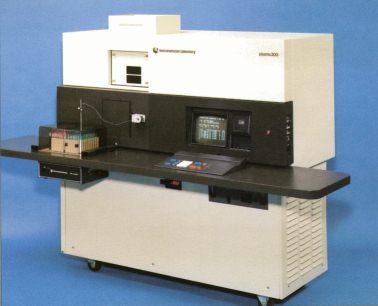|
Instrument Database:
Instrumentation Laboratory - IL PLASMA-200 Sequential ICP Spectrometer
( Thermo Scientific )
| |
|

|
| |
|
| |
|
| Year of introduction |
1983 |
| Status |
historical ( out of service ) |
| Company |
Instrumentation Laboratory
|
| Categories |
Spectrometer ( Atom. ): AES: ICP-AES
|
|
The IL Plasma-200 is an emission spectrometer utilizing an inductively coupled plasma (lCP) source. It can determine up to seventy elements in a wide variety of materials. The elements are determined in rapid sequence under microcomputer control. Results are displayed on a built-in video screen and can be printed on the line printer. Individual analytical methods are developed using an ASCII keyboard and graphics displayed on the video screen. These methods can then be stored on magnetic tape cassettes, or on disk using one of two external data system options. For routine operation, the double-sided keyboard can be turned over. The second side controls the operation of the entire instrument with only ten function keys and a number pad. The IL Plasma-200 instrument is selfcontained and compact, occupying approximately the same floor space as an office desk. It can determine up to 24 elements in a sampie in one minute after plasma torch equilibration, when the optional second channel is used. In routine operation it is simpler to use than even the most automated atomic absorption spectrophotometer.
|
| Specifications |
|
Dimensions (w x d x h in cm)
| 75 x 120 x 163
| Weight (kg)
| | Power
| 3 phase; 50/60 Hz; 200, 208, 380, or 415V.
6500W
| Spectrometer
| Ebert-Fastie double monochromator for reduced stray-light, 330 mm primary monochromator and a 165 mm secondary monochromator, air path (2nd channel vacuum optional); mercury lamp for wavelength calibration;
| | Grating | holographic, 1200 lines/mm, blazed at 500 nm, used in first order above 365 nm, second order below 365 nm
| Optics
| fused silica lens and quartz coated mirror within entrance optic is tilted under computer control to adjust observation zone for each element (observation height: 0-48 mm)
| | Wavelength range | 185 - 900 nm
| Wavelength drive
| stepper motor driven grating drive, step width 5 pm; refractory plate driven in steps of 1 pm
| | Resolution | | | Detector | | Detection mode
| | | Read out | |
| | ICP generator
| crystal-controlled, computer controlled ignition
| | Frequency (MHz) | 27.12
| Power (Watt)
| 2000
| Load coil
| | Torch
| demountable torch, sapphire injector optional,
| Argon flow (L/min)
| 15-20
|
| | | Sample introduction | cross-flow nebulizer with sapphire orifices, computer-controlled peristaltic pump, polypropylen spraychamber,
| Operating system and software
| Software written in FORTH
| Computer
| Integrated Intel 8080A microprocessor; miniature magnetic cassettes for data storage, line printer, build-in video monitor
| Short term precision (RSD for 10 replicates)
| | Long term precision (RSD for 4 hours)
| | Sensitivity
| | | Detection limits (3s, µg/L) | | Accessories
| 95-place autosampler, PHD Hydride Generator, PDS-1 Data station (Tandy TRS-80)
| Special features
| Up to 18/24 elements can be determined per minute with single/double channel option
|
|
|